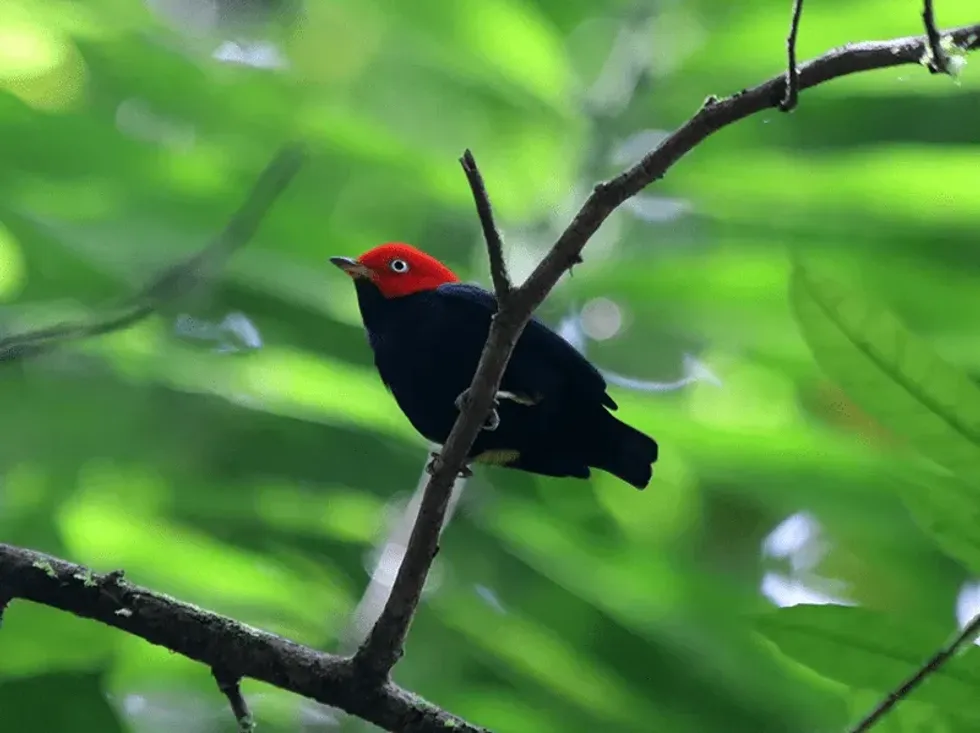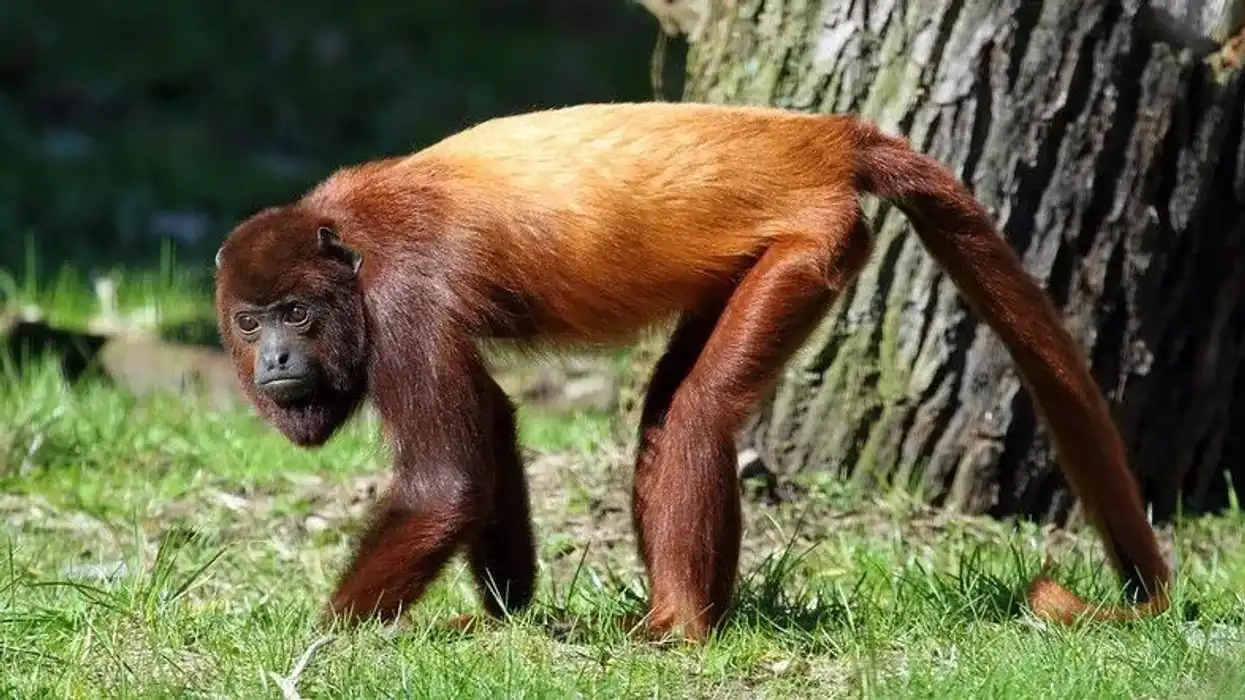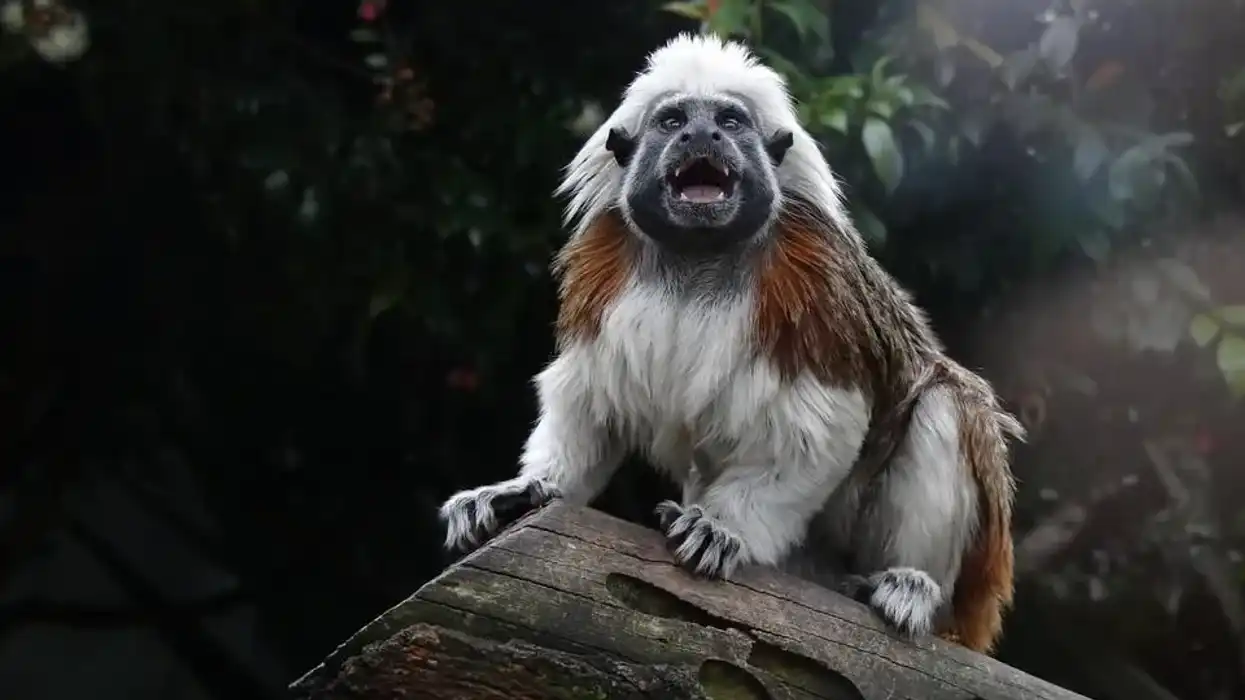Red-capped manakins are one of the 52 different Pipra genus species of the bird category.
Their name is aptly based on the small red and round heads of males with black bodies and yellow-colored legs. This wild bird is mainly found in the region of Mexico in North America, as well as in Costa Rica, Columbia, Panama, Ecuador, Peru, and Guatemala, and its presence is in abundance.
Even though they are currently listed as Least Concern by the IUCN, their population is said to have decreased considerably over the years.
This bird is particularly famous because of its interesting courtship ritual. In this ritual, a male is supposed to dance in a way that resembles the moonwalk by moving up and down on the branch, showing off its thighs and its velvety wings to attract a mate.
They flap their wings in a rapid motion that makes a sound which is helpful in this process.
Interesting, isn't it? To know more interesting facts about this bird, carry on reading this article. For more interesting fact files about other animals, check out our articles on Guam rail and keel-billed toucan.
Red-Capped Manakin Interesting Facts
What type of animal is a red-capped manakin?
The red-capped manakin (Ceratopipra mentalis) as its scientific name suggests, is a bird belonging to the Pipridae family of animals.
What class of animal does a red-capped manakin belong to?
This Ceratopipra genus of bird from Mexico belongs to the Aves class of animals.
How many red-capped manakins are there in the world?
Although these birds from Mexico are not in danger of going extinct, their exact number in the current wildlife is yet unknown.
Where does a red-capped manakin live?
This species of bird is known as the bird of Central America. The red-capped manakin range is found mainly in the regions of Costa Rica, Peru, Ecuador, Panama, and many parts of Mexico.
What is a red-capped manakin's habitat?
A red-capped manakin bird is found in the evergreen forest. They are tropical birds and find it favorable to live in semi-deciduous and humid forests and woodlands in Ecuador, Panama, and Costa Rica. These are regions where the temperature is perfect for them, and the supply of fruits is in abundance as that is their basic diet.
Who do red-capped manakins live with?
Although a female red-capped manakin, as well as a male manakin, are known to be solitary, these birds are known to engage in mixed feeding flocks where they forage with other bird species. The only time males are seen in their small groups is during red-capped manakin courtship and the breeding period to engage with females.
How long does a red-capped manakin live?
Although the exact lifespan is not known, red-capped manakin evolution says that they might be able to live up to ten or more years when they are in their favorable habitat.
How do they reproduce?
The mating system of red-capped manakins is active between February and July. During this period, males perform a red-capped manakin mating dance which is similar to the moonwalk, moving up and down on tree branches.
This red-capped manakin display focuses on the fast-flapping of wings and thighs to get the attention of a preferred red-capped manakin female as a mate.
During this mating period, males are known to come together in small groups that are called leks.
Lekking is an act of showing off the red-capped manakin moonwalk dance as a courtship ritual to attract a mate.
Once a female agrees, the red-capped manakin mating system is said to finish, after which females build a small cup-shaped nest in the forest at a medium height and lays around two eggs. Females incubate the eggs for a period of 15 to a maximum of 23 days before the baby hatches from the egg.
These females are known to care for their family of young ones alone for a span of 13 to 15 days in totality until they can be independent.
What is their conservation status?
By the red-capped manakin evolutionary history, the red-capped manakin subspecies of the manakin birds are included in the Least Concern bracket of the IUCN Red List.
Red-Capped Manakin Fun Facts
What do red-capped manakins look like?
Red-capped manakin males and females have different colors and can be distinguished easily based on their physical appearance. A male has a black velvety body with a red nape and head, whereas a female has an olive-green colored body with light yellow-green underparts.
This bird species is known to have wing linings with paler feathers. A male has yellow legs and chin, while a female has light brown legs.
A male manakin has a white iris, whereas a female manakin, just like the young ones, has a brown one. Irrespective of the other physical differences, both these male and female birds have short bills with a wide base and short tails.
An adult and juvenile red-capped bird can be distinguished from the paler olive green color in juveniles and comparatively bright colors in adult females, and the red, black, and yellow shades in an adult male.

How cute are they?
This bird species is considered to be cute, especially the male bird with its red-capped manakin dance of fancy moonwalk moves and bright-colored body. This bird makes it a worthwhile sight for the onlookers. A female bird might be confused with a young bird but is considered to be equally as pretty.
How do they communicate?
Although this bird is thought to belong to the quiet bird family, it is still known to communicate with loud vocal calls. A male bird is known to use most of the vocalizations and body sounds that it creates, flapping its wing rapidly, especially during the mating season. A male bird calls short notes of 'psit-psit'.
How big is a red-capped manakin?
The red-capped manakin of Panama, Ecuador, and Costa Rica is considered to be larger than the tiny tyrant manakin bird species. Its size can be between 4-6 in (10-15 cm).
How fast can a red-capped manakin fly?
Although the exact speed of these birds is not known, the red-capped manakin in flight is said to be quite quick and efficient thanks to their fluffed wings and plumage.
How much does a red-capped manakin weigh?
This bird is a small one with a bodyweight of 0.02-0.06 lb (9-27 g), which is double the weight of a tiny tyrant manakin bird.
What are the male and female names of the species?
Although a group of male birds during the mating season is called a lek, there is no specific name for a male or a female bird living in the forests of Panama, Ecuador, or Costa Rica.
What would you call a baby red-capped manakin?
A red-capped manakin baby is called a chick, just like many other species of birds.
What do they eat?
The major diet of this bird from Panama, Ecuador, and other South American countries consists of fruits from forest vegetation. They feed on wild berries and various kinds of fruit that have a lot of water content.
These birds are usually seen foraging with other birds who feed on insects, rather than fruit. This might be a reason why some individuals of this species are seen pecking at small insects at times.
Are they aggressive?
There is no record of this kind of pipra bird with an aggressive history. Even during the mating season, the male bird engages in a competitive dance showcase but isn't aggressive toward the competition in any way.
Would they make a good pet?
These birds are found in large numbers in the forests of Ecuador, Panama, Mexico, Costa Rica, Columbia, Peru, and Guatemala. They are considered to live in the wild and there haven't been many records of these birds being kept in captivity.
Did you know...
These birds, just like many other species, engage in courtship rituals where the male carries out a dance sequence and makes a sound with its wing to attract a female. This is mainly done by birds so that it is easier for females to recognize their kind of male partners and choose a mate of their kind.
Red-capped manakins are considered to be residential. Although during the change of seasons, a few individuals try to fly and migrate to places where specific fruits ripen.
Most red-capped manakins get caught in mist nets due to changing weather conditions and end up risking their lives. As these migrations happen very rarely and in small quantities, these birds are not specifically known to be migratory.
What sound do red-capped manakins make?
Apart from the 'psit-psit' calls, these birds are known to make nonvocal sounds with a wing. The male population is famous for its moonwalk dance and the sounds that they create during these mating seasons by snapping their wings in a fast motion while attracting a female.
When was the red-capped manakin discovered?
The first-ever remains of this bird were collected in 1857 in southern Mexico. These remains were then studied by an English zoologist named Philip Sclater, who was responsible for describing this bird.
He placed it in the pipra genus like the other similar species. The bird was named a Pipra mentalis, having its roots in the Latin language, which meant 'something that pertains to the chin'. This was because of the bird's yellow-colored chin.
Later due to the distinction of a few taxonomical reasons, this pipra bird was recognized and added to the Ceratopipra genus. Along with the species itself, the red-capped manakin adaptations have been studied ever since its discovery.
Here at Kidadl, we have carefully created lots of interesting family-friendly animal facts for everyone to discover! Learn more about some other birds including tawny owls or palm cockatoo.
You can even occupy yourself at home by drawing one on our Red-capped manakin coloring pages.










